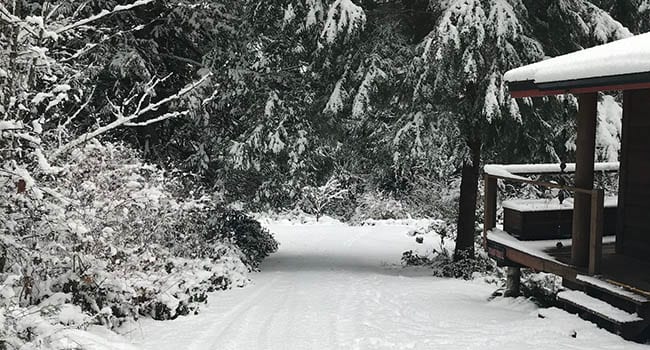 The humpback whales were still breaching and blowing as we crossed by ferry from Little River to Powell River on our way back to Skelhp after a week with friends.
The humpback whales were still breaching and blowing as we crossed by ferry from Little River to Powell River on our way back to Skelhp after a week with friends.
In mid-December, the big ocean visitors begin their travels south, and once again the local orcas and sea lions become the dominant residents of the Salish Sea.
The last of the chum salmon have spawned and the black bears have feasted on their dead carcasses before heading off to den. Many of the sea ducks have also flown on to their winter territories.
At this time of the year, Skelhp quietens as the winter rains and near-freezing nights begin. And it’s dark – last night the sun set at 4:12 p.m.
Very occasionally, the early onset of night is postponed as we enjoy a spectacular sunset framed between Texada Island’s mountainous backbone and a dark grey belt of cloud ceiling. Through this gap streams a beauteous band of red and yellow light that even transforms the waters of Jervis Inlet with an almost electric palette of colour.
When I post photos of these sunsets, my Facebook account lights up with Christmas joy in the form of ‘likes,’ from friends in Calgary and Vancouver, and as far away as Lovozero in the Kola Peninsula of Siberia.
Long, cold nights inspire warm, social evenings at Skelhp. Our Hardy Island granite chimney and fireplace are put to daily use by mid-December, as we burn the wood cut and split at our annual November Woodcamp, when my school chums help prepare one or two cords of Douglas fir and red cedar.
The roaring evening fire slowly heats the granite blocks of the fireplace and they remain warm until early the next morning, radiating their warmth throughout the house as we sleep.
Skelhp House itself also warms socially as family members gather in the third week of December for the Christmas season. Niece and nephew, daughter and son, sister and wife and I are now celebrating our sixth Christmas together in the forest by the sea.
All of the Christmas rituals are observed, with family-caught spring salmon, Russian kale from the vegetable garden, and family-baked cookies and cakes taking pride of place at the pre-Christmas dinners.
Elaborate toasts have evolved to begin each meal and our favourite music is always an accompaniment.
Scottish plaids and tartans have lately dominated the dress code but it’s impossible to guess what new costumes will appear each year.
Fundamental to our celebrations is, of course, the Christmas tree. We always harvest one of our local firs for this purpose, according to another evolving ritual. The millennial members of the family head into the bush the day before Christmas with a saw and a shared image of the perfect tree.
After several hours, they reappear with the perfect tree hoisted on their shoulders. It’s traditionally tall – the house ceilings are high enough to accommodate a 15-footer.
Once carefully clamped into its stand, the tree is quickly decorated by all hands. Creative homemade decorations have been gathered over the years, and their growing numbers supplement a declining number of store-bought red and green glass balls that seem to fall off and shatter with seasonal regularity.
When its decor is complete, the Skelhp tree is a symbol of family unity and purpose.
Before Christmas Eve ends, beautifully-wrapped presents begin to appear under the tree, somewhat magically from closets, boxes and bags around the house. Christmas stockings are also secretly prepared by a committee of elves.
By about 10 p.m., the family has drifted off to bedrooms. Just about every Christmas Eve, sleep is heralded by a growing thrum of rain on the metal roof. The continuous rhythmic humming induces slumber in the rainforest.
Christmas morning begins with a group phone call to my 97-year-old mom. She can no longer make the trek from Vancouver to Skelhp, and two years ago had to give up her apartment for a seniors’ residence.
The morning call is our bond with her and everyone takes their time sending her love from the Sunshine Coast. She embodies our Skelhp Christmas spirit.
Mike Robinson has been CEO of three Canadian NGOs: the Arctic Institute of North America, the Glenbow Museum and the Bill Reid Gallery. Mike has chaired the national boards of Friends of the Earth, the David Suzuki Foundation, and the Canadian Parks and Wilderness Society. In 2004, he became a Member of the Order of Canada.
The views, opinions and positions expressed by columnists and contributors are the author’s alone. They do not inherently or expressly reflect the views, opinions and/or positions of our publication.


